DuraHeat DH2304 Instrucciones de operación
- Categoría
- Calentadores espaciales
- Tipo
- Instrucciones de operación
Este manual también es adecuado para

CAUTION: "RISK OF BURNS"
DO NOT OPERATE HEATER WITHOUT INSTALLING THE PROTECTIVE GUARD OR GRILL.
1. REMOVE THE HEATER AND ALL PACKING MATERIALS FROM THE BOX. (Fig.2)
NOTE :
Save the shipping carton and packing
materials for future storage.
8
UNPACKING AND ASSEMBLY
Heater.
Top guard.
Handle.
Top plate
2 “C” cell batteries.
Siphon pump.
Bag of screws for top grill assembly.
Owner's manual.
Safety Tips Manual.
2. ASSEMBLING.
A) Remove all packing materials from heater:
(Fig.3)
B) MOUNTING TOP PLATE: (Fig.4)
Align the arrow marking on the top plate with the carrying
handle hole on the cabinet and place the top plate on the
cabinet.
C) INSTALLING FRONT AND REAR GUARDS:
(Fig.5A and Fig.5B)
Hang the upper portion of the front guard (notched to
allow for the igniter door) on the Upper Grill brackets with
the downward hooked grill rods. (Fig.5A)
Snap the lower portion of the front guard into the holes in
the Lower Grill brackets with the inward hooked grill
rods. (Fig.5B)
Install the rear guard in the same way.
Top plate
Carrying handle
Top guard
Batteries
Rear guard
Front guard
Siphon Pump
Top guard Screws
Fig.2
Fig.4Fig.3
Fig.5B
Fig.5A
arrow marking
carrying handle hole
NEVER LEAVE THE HEATER
UNATTENDED WHILE BURNING
!

NEVER LEAVE THE HEATER
UNATTENDED WHILE BURNING
!
NEVER LEAVE THE HEATER
UNATTENDED WHILE BURNING
!
9
KEROSENE SHOULD ONLY BE STORED IN A BLUE CONTAINER THAT IS CLEARLY MARKED
"KEROSENE". NEVER STORE KEROSENE IN A RED CONTAINER. Red containers are associated with gasoline.
NEVER store kerosene in the living space. Kerosene should be stored in a well ventilated place outside the
living area.
NEVER use any fuel other than 1-K kerosene.
NEVER use fuel such as gasoline, benzene, alcohol, white gas, camp stove fuel, paint thinners, or other oil
compounds in this heater. These are volatile fuels that can cause explosion or uncontrolled flames.
The best way to purchase kerosene is in a pre-packaged, metal or plastic, blue colored container.
The second choice would be to buy it from a dealer who stores it in a 55 gallon drum. The third choice is to
buy kerosene from a dealer who stores it in a large underground (or above ground) tank. Kerosene that is
contaminated with even a small amount of water will prevent a kerosene heater from functioning properly.
As you move from the first choice in purchasing kerosene (pre-packaged container) to the third choice (large
storage tank), the likelihood of water being present from condensation increases.
If you purchase kerosene in bulk, know your dealer.
It is
EXTREMELY IMPORTANT to the operation of this heater that you use
the proper grade of kerosene. The proper grade of kerosene is identified as
1-K Kerosene. DO NOT OPERATE THIS HEATER WITH ANY FUEL
OTHER THAN 1-K KEROSENE! 1-K Kerosene has been refined to
virtually eliminate contaminants such as sulfur, which can cause a rotten
egg odor during operation of the heater.
Due to IRS regulations 1-K kerosene is now dyed red in many areas.
D) INSTALLING CARRYING HANDLE:
(Fig.6)
Insert the carrying handle into the holes on the cabinet
by aligning holes on brackets of top plate.
E) INSTALLING TOP GUARD: (Fig.7)
Align the 2 brackets on the top guard with the 2 mounting
brackets on the front and rear guards.
Secure each bracket with a screw. Make sure that the
brackets on the top guard are positioned outside the
mounting brackets on the front and rear guards.
F) INSTALLING BATTERIES: (Fig.8)
Battery holder is located on the back of the heater.
Open the battery cover from the battery case.
Insert two(2) “C” cell batteries according to the plus(+)
and minus(-) markings inside of the holder.
Replace the battery cover to the heater.
G) Now your heater is completely assembled: (Fig.9)
KEROSENE (1-K ONLY)
Fig.8
Fig.9
Fig.6
Fig.7
Top Grill Screw

NEVER LEAVE THE HEATER
UNATTENDED WHILE BURNING
!
10
It is normal for a kerosene heater to give off a slight odor upon start-up and shut-down.
After 5-10 minutes of operation, the heater should have reached its normal operating temperature and any
odor should be very slight.
NEVER store kerosene in direct sunlight or near a source of heat.
NEVER use kerosene that has been stored from one season to the next.
Kerosene deteriorates over time.
"OLD KEROSENE" WILL NOT BURN PROPERLY IN
THIS HEATER.
A variety of problems can result from using poor quality kerosene --- smoke, odor, low flame, difficult ignition,
difficult shut-down, flame flickers and dies, excessive burning down of the wick, reduced wick life, wick
adjuster sticking, excessive deposits on the wick, etc.. If you encounter any of the problems listed above,
check your kerosene. If you discover that the kerosene is the problem, get a fresh supply of
1-K KEROSENE
before using your heater again.
FUELING YOUR HEATER
NEVER FILL THE HEATER FUEL TANK IN THE LIVING SPACE:
FILL THE TANK OUTDOORS.
Before fueling the heater, take the heater, the kerosene, and the manual
siphon pump outdoors. To use the manual siphon pump, tighten the cap
on the top of the siphon, place the straight tube into the kerosene
container, and insert the flexible tube into the opening of the fuel tank. By
squeezing the bulb of the siphon pump, fuel will be transferred from the
kerosene container into the heater tank (Fig.10). Carefully watch the fuel
gauge on the base of the heater so that you will know when the tank is
getting full. When you approach the full mark, loosen the cap on top of the
siphon pump. This will stop the flow of kerosene.
DO NOT OVERFILL
YOUR HEATER. Allow the siphon pump to drain thoroughly before you
remove it from the tank and the kerosene container.
Fig.10
Fig.11
LOOSEN
TIGHTEN
After fueling the fuel tank of the heater by using siphon pump, make sure
that you loosen (counter clock wise) the cap on the siphon pump to drain
thoroughly the remaining kerosene in the siphon pump. For the reuse of
siphon pump, make sure that youtighten (clock wise) the cap on the
siphon pump to transfer the kerosene into the fuel tank properly. (Fig.11)
IMPORTANT NOTICE REGARDING FUELING OF THE HEATER :
When fueling your heater for the first
time and any other time when the tank has been completely empty, as in
"
Dry Burning
"
(page 8) make sure
to allow the wick to soak a minimum 60 minutes before you attempt to light the heater. Take note of the
time you started to soak the wick or use a kitchen timer or wrist watch with an alarm feature. Failure to
properly soak the wick can trap air pockets in the wick causing the heater to burn poorly.
Premature ignition can destroy your wick.
IMPORTANT NOTICE REGARDING FIRST IGNITION OF HEATER
The first time you light your heater there may be some odor due to the burning off of oils used in the
manufacturing process. To avoid this you may wish to burn the heater outside on a calm and windless day.
If it’s windy consider a porch or garage or other room where the windows can be open to disperse the odor.

NEVER LEAVE THE HEATER
UNATTENDED WHILE BURNING
!
11
31.giF21.giF
AUTOMATIC IGNITION SYSTEM
For safety and convenience, this heater features an automatic ignition system.
2 "C" cell batteries, included with the heater, provide the power for the igniter which lights the wick once it has
been raised to its maximum height.
To use the automatic ignition system:
Make sure the batteries have been installed.
Turn the wick adjuster knob clockwise until the wick has been raised to its maximum height. (Fig.12)
Push the ignition lever (Fig.13) to bring the glowing igniter into contact with the wick.
This will cause ignition to occur.
As soon as you see that the wick has been lit, release the ignition lever. This will automatically lower
the burn chamber back down over the wick.
Rotate the burner knob from side to side a few times to make sure that the burner is positioned
properly on the wick adjuster.
Then begin following the steps outlined in "Adjusting the wick" (page 7)
IGNITION VIA MATCH
If you encounter a problem with the ignition mechanism, or if you have dead
batteries, it is possible to light the heater with a match. (Fig.14)
The procedure is as follows:
Turn the wick adjuster knob clockwise until the wick has been
raised to its maximum height.
Lift the burn chamber by using the burner knob.
Touch a lighted match to the exposed top edge of the wick.
Once you see that the wick has been lit, lower the burn chamber back down over the wick.
Rotate the burner knob from side to side a few times to make sure that the burner is positioned
properly on the wick adjuster.
Then begin following the steps outlined in "Adjusting the wick" (page 7)
CAUTION : Make sure that you do not leave the match, or any portion of it (match head, etc.) in the burner
area. Debris left from the match can cause an uneven alignment of the burner and may result in
smoke, incomplete combustion, odor, or fire.
Fig.14
Match
WICK
FlLAMENT
IGNITER
1~2mm

8
DESEMPACAMIENTO Y MONTAJE
ADVERTENCIA: "RIESGO DE QUEMADURAS."
NO USE EL CALENTADOR SIN INSTALAR LA CERCA PROTECTORA (LA VERJA)
1.
SAQUE EL CALENTADOR Y TODOS LOS MATERIALES DE EMBALAJE DE LA CAJA. (Ilu. 2)
NOTA: Guarde el cartón del envío y los materiales
de embalaje para el almacenamiento futuro.
• Calentador
• Verja de la cima
• Asa
• Plato de la cima
• 2 pilas “C”
• Bomba sifón
• La bolsa de tornillos para armar la verja de cima
• El Manual del dueño
• Manual de consejos para la seguridad
2.
ARMAR
A) Quite todos los materiales de embalaje del calentador: (Ilu. 3)
B)
MONTAR PLATO DE LA CIMA: (Ilu. 4)
Alinee la flecha de la placa superior con el orificio del mango
del compartimento.
A continuación, coloque la placa superior en el compartimento.
C)
INSTALACION DE PROTECTORES DELANTEROS
Y POSTERIORES:
(Ilu. 5A, Ilu. 5B)
• Ponga la parte superior de la cubierta frontal (con una
ranura para permitir el paso de la puerta del encendedor)
en los soportes de la parrilla superior con las barras
enganchadas hacia abajo (Ilu. 5A).
• Introduzca la parte inferior de la cubierta frontal en los orifi-
cios de la parte inferior.
Soportes de la parrilla con las barras enganchadas hacia
dentro (Ilu. 5B).
• Instale el protector posterior de la misma manera
3
Plato de la cima
Asa
La verja de la cima
Pilas
La verja trasera
La verja delantera
Bomba sifón
tornillos para montaje de la cima
Ilustración 2
Ilustración 4Ilustración 3
flecha
orificio del mango
Ilustración 5B
Ilustración 5A

9
D) INSTALAR EL ASA PARA LLEVAR ASA: (Ilu. 6)
Inserte el asa en los agujeros en el gabinete por alinear los
agujeros en los puntales del plato de la cima.
E) INSTALAR LA VERJA DE LA CIMA: (Ilu. 7)
Alinee los 2 puntales de la verja de la cima con los 2 puntales de
montar en las verjas delanteras y traseras. Afiance cada puntal con
un tornillo. Asegúrese que se posicionan los puntales en la verja de
la cima dentro de los puntales de monta en las verjas delanteras y
traseras.
F) INSTALAR LAS PILAS: (Ilu. 8)
• La caja de la pila se localiza en la parte de atrás del
calentador.
• Abra la tapa de la caja de pilas.
• Inserte dos (2) pilas “C” según los marcos para el positivo (+) y
negativo (-) dentro de la caja.
• Reemplace la tapa de la caja al calentador.
G) Ahora su calentador está completamente armado. (Ilu. 9)
QUEROSÉN (1-K Sólo)
Es SUMAMENTE IMPORTANTE al funcionamiento de este calentador que usted use la
calidad correcta de querosén. La calidad correcta de querosén se identifica como 1-K
Querosén. ¡No USE ESTE CALENTADOR CON CUALQUIER otro COMBUSTIBLE
que 1-K QUEROSÉN! Se ha refinado 1-K querosén para eliminar práctimente toda
contaminacion como azufre que puede causar un olor del huevo podrido durante el
funcionamiento del calentador.
Debido a regulaciones de IRS Queroseno de l K ahora es teñido rojo en muchas áreas.
SOLO DEBE GUARDARSE EL QUEROSÉN EN UN RECIPIENTE AZUL QUE ES CLARAMENTE MARCADO
"QUEROSÉN." NUNCA GUARDE EL QUEROSÉN EN UN RECIPIENTE ROJO. Los recipientes rojos son asociados con
gasolina.
NUNCA guarde el querosén en el espacio de vivir. Debe guardarse querosén en un lugar bien ventilado fuera del
área de vivir.
NUNCA use cualquier otro combustible que 1-K querosén.
NUNCA use combustible como gasolina, benceno, alcohol, gas blanco, combustible de estufa de campamento, aguarrás
de la pintura, u otros compuestos de aceite en este calentador. Éstos son combustibles volátiles que pueden
causar explosión o las llamas desenfrenadas.
La manera mejor de comprar querosén es en un recipiente pre-empaquetado, metal o plástico, de color azul. La segunda
opción sería comprarlo de un distribuidor que lo guarda en un bidón de 55 galónes. La tercera opción es comprar querosén de
un distribuidor que lo guarda en un tanque grande en el subsuelo (o sobre tierra). Querosén que se contamina con incluso una
cantidad pequeña de agua impedirá a un calentador de querosén funcionar correctamente. Cuando usted cambia de la primera
opción de comprar querosén (recipiente pre-empaquetado ) a la tercera opción (tanque grande de almacenamiento), la
probabilidad de que agua esté presente de la condensación es más. Si usted compra querosén a granel, conozca a su
distribuidor.
4
Ilustración 8
Ilustración 9
Ilustración 6
Ilustración 7
Tornillo de la parrilla superior

10
Es normal para un calentador de querosén emitir un olor ligero al encender y apagar.
Después de 5-10 minutos de funcionamiento, el calentador debe de haber alcanzado su temperatura de funcionar normal y
cualquier olor debe ser muy poco.
NUNCA guarde el querosén en luz del sol directa o cerca de una fuente de calor.
NUNCA use querosén que se ha guardado de una estación del año a la próxima. El querosén se deteriora con el tiempo.
"QUEROSÉN VIEJO" no QUEMARÁ CORRECTAMENTE EN ESTE CALENTADOR.
Una variedad de problemas pueden ser el resultado de usar querosén de calidad pobre--- humo, olor, llama baja, la ignición
difícil, el apagar difícil, la llama vacila y se muere, el quemar excesivo de la mecha, la vida reducida de la mecha , ajustador de
la mecha se traba, depósitos excesivos en la mecha, etc. Si usted encuentra cualquiera de los problemas listados, averigüe la
calidad de su querosén. Si usted descubre que el querosén es el problema, consigue un suministro fresco de
1-K QUEROSÉN
antes de usar su calentador de nuevo.
ALIMENTAR SU CALENTADOR
NUNCA LLENE EL TANQUE de COMBUSTIBLE de CALENTADOR EN EL ESPACIO DE VIVIR.
LLENE EL TANQUE AFUERA AL AIRE LIBRE.
Antes del alimentar el calentador, tome el calentador, el querosén, y la bomba
sifón manual al aire libre. Para usar la bomba sifón manual, apriete la tapa en
la cabeza del sifón, ponga el tubo recto en el recipiente de querosén, y inserte
el tubo flexible en la apertura del tanque de combustible. Por apretar la bombilla
de la bomba sifón, se transferirá combustible del recipiente de querosén al
tanque del calentador (Ilu. 10). Cuidadosamente mira el indicador de com-
bustible en la base del calentador para que usted sepa cuando el tanque está
poniéndose lleno. Cuando usted se acerca a la marca llena, suelte la tapa enci-
ma de la bomba sifón. Esto detendrá el flujo de querosén.
NO SOBRELLENE
SU CALENTADOR.
Permita la bomba sifón escurrirse completamente antes de
que usted lo quite del tanque y el recipiente de querosén.
Después del alimentar el tanque de combustible del calentador por usar la
bomba sifón, asegurese que usted suelta (en sentido contravio al de las
agujas del reloj) la tapa en la bomba sifón para vertir el querosén restante
completamente de la bomba sifón. Para usar de nuevo la bomba sifón, ase-
gurese que usted aprieta (en el sentido de las agujas del reloj) la tapa en la
bomba sifón para transferir el querosén correctamente en el tanque de
combustible. (Ilu. 11)
AVISO IMPORTANTE CON RESPECTO A LA PRIMERA ALIMENTACIÓN DEL CALENTADOR
Cuando primero usa su calentador, asegurese que usted deje un mínimo de 60 minutos (cuidadosamente mire el tiempo)
después de llenar el tanque antes de que usted intente encender el calentador. Esto da tiempo que la mecha se sature.
AVISO IMPORTANTE CON RESPECTO A LA PRIMERA IGNICION DE CALENTADOR
La primera vez usted enciende el calentador, debe hacerse afuera, al aire libre. Esto permite que los aceites, etc., usados en la
fabricación del calentador se quemen afuera en lugar de dentro de su casa.
AVISO IMPORTANTE: NUNCA el re llene el tanque del calentador con combustible cuando el calentador todavía está en
uso o caliente.
5
Ilustración 10
Ilustración 11
suelte
apriétese

11
SISTEMA DE IGNICION AUTOMATICO
Para la seguridad y comodidad, este calentador ofrece un sistema de ignición automático, 2 pilas "C", incluidas con el calenta-
dor, mantienen el poder del mechero que enciende la mecha cuando ésta se ha subido a su altura máxima.
Para usar el sistema de ignición automático:
- Asegúrese que las pilas se han instalado.
- Gire el ajustador de mecha en el sentido de las agujas del reloj hasta que la mecha se ha subido
a su altura máxima. (Ilu. 12)
- Tire en la palanca de ignición (Ilu. 13) para traer el mechero resplandeciente en contacto con la mecha.
Esto causará la ignición.
- En cuanto usted vea que la mecha se ha encendido, suelte la palanca de la ignición. Esto bajará la cámara de
quemar automáticamente sobre la mecha.
- Gire el bulto del quemador de un lado al otro unas veces para asegurarse que el quemador se posiciona
correctamente en el ajustador de la mecha.
- Entonces empiece seguir los pasos dados en "ajustar la mecha" (página 7)
IGNICION POR FOSFORO
Si usted encuentra un problema con el mecanismo de la ignición, o si usted tiene pilas gas-
tadas, es posible encender el calentador con un fósforo (Ilu. 14).
El procedimiento es el siguiente:
- Gire ajustador de mecha en el sentido de las agujas del reloj hasta que
la mecha se haya levantado a su altura máxima.
- Levante la cámara de quemar por usar el bulto del quemador.
- Ponga un fósforo encendido al borde de la cima expuesto de la mecha.
- Una vez que usted vea que la mecha se ha encendido, baje la cámara de la quemar sobre la mecha.
- Gire el bulto del quemador de un lado al otro unas veces para asegurarse que el quemador se
posiciona correctamente en el ajustador de la mecha.
- Entonces empiece siguir los pasos dados en "Ajustar la mecha" (página 7)
CUATELA: Asegurese que usted no deja el fósforo, o cualquier parte de él (cabeza del fósforo, etc.) en el área
del quemador. Ruinas del fósforo pueden causar una alineación desigual del quemador y pueden
producir humo, combustión incompleta, olor, o fuego.
6
Ilustración 14
Ilustración 12
Ilustración 13
fósforo
mecha
filamento
igniter
-
 1
1
-
 2
2
-
 3
3
-
 4
4
-
 5
5
-
 6
6
-
 7
7
-
 8
8
DuraHeat DH2304 Instrucciones de operación
- Categoría
- Calentadores espaciales
- Tipo
- Instrucciones de operación
- Este manual también es adecuado para
en otros idiomas
Artículos relacionados
-
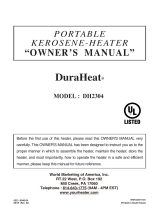 DuraHeat DH2304S Manual de usuario
DuraHeat DH2304S Manual de usuario
-
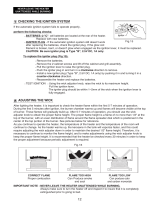 DuraHeat DH2304S Manual de usuario
DuraHeat DH2304S Manual de usuario
-
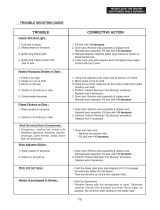 DuraHeat DH2304S Guía del usuario
DuraHeat DH2304S Guía del usuario
-
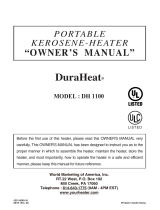 DuraHeat DH1100 Manual de usuario
DuraHeat DH1100 Manual de usuario
-
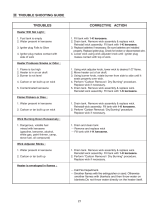 DuraHeat DH1100 Guía del usuario
DuraHeat DH1100 Guía del usuario
-
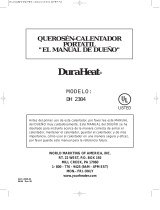 DuraHeat DH2304 Guía de instalación
DuraHeat DH2304 Guía de instalación
-
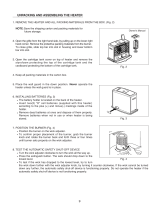 DuraHeat DH1100 Guía de instalación
DuraHeat DH1100 Guía de instalación
-
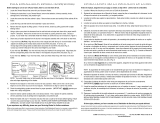 DuraHeat DH-322 Guía de instalación
DuraHeat DH-322 Guía de instalación
-
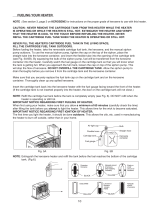 DuraHeat DH1100 Guía del usuario
DuraHeat DH1100 Guía del usuario
-
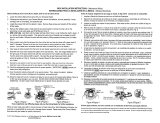 DuraHeat DH-121 Guía de instalación
DuraHeat DH-121 Guía de instalación

















